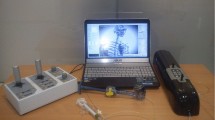Abstract
The base of all training in interventional radiology relies on the development of the core skills in manipulating the instruments. Computer simulators are emerging to help in this task with virtual reality simulators and haptic devices. This paper extends our previous interventional radiology training framework with two new virtual instruments: a stent and a balloon, both driven by the previously existing catheters and guidewires. Both the balloon and stent are used to treat stenosis, a partial or total blockage of an artery. The inflating balloon and/or the expanding stent are used to increase and maintain the radius of the artery during the intervention. A mass–spring particle system is used to model the new instruments. This modelling allows realistic instrument behaviour in real time, even in complex vascular anatomies, because of efficient collision interactions. The collision response is based on four constraints applied to the instruments: external force, spring force, and 2D and 3D bending forces. The behaviour of our simulated instruments has been visually assessed by experienced interventional radiologists, who described it as realistic and potentially helpful for training.









Similar content being viewed by others
Explore related subjects
Discover the latest articles, news and stories from top researchers in related subjects.References
Seymour, N.E., Gallagher, A.G., Roman, S.A., et al.: Virtual reality training improves operating room performance: results of a randomized, double-blinded study. Ann. Surg. 236, 458–463 (2002)
Chaer, R.A., DeRubertis, B.G., Lin, S.C., et al.: Simulation improves resident performance in catheter based intervention. Ann. Surg. 244(3), 343–349 (2006)
Lenoir, J., Cotin, S., Duriez, C., Neumann, P.: Physics-based models for catheter, guidewire and stent simulation. Stud. Health Technol. Inform. 119, 305–310 (2006)
Zahedmanesh, H., John Kelly, D., Lally, C.: Simulation of a balloon expandable stent in a realistic coronary artery—determination of the optimum modelling strategy. J. Biomech. 43(11), 2126–2132 (2010)
Záhora, J., Bezrouk, A., Hanus, J.: Models of stents—comparison and applications. Physiol. Res. 56 Suppl(1), S115–S121 (2007)
Luboz, V., Blazewski, R., Gould, D., Bello, F.: Real-time guidewire simulation in complex vascular models. Vis. Comput. 25(9), 827–834 (2009)
Zhou, X., Luboz, V., Gould, D.A., Bello, F.: Vessel deformation simulation. In: Proceedings of the Virtual Reality International Conference (VRIC) (2010)
Duerig, T.W., Wholey, M.: A comparison of balloon and self-expanding stents. Minim. Invasive Ther. Allied Technol. 11(4), 173–178 (2002)
Acknowledgements
This work was partly funded by the Digital Economy program of the EPSRC, the UK Engineering and Physical Sciences Research Council.
Author information
Authors and Affiliations
Corresponding author
Electronic Supplementary Material
Below is the link to the electronic supplementary material.
Rights and permissions
About this article
Cite this article
Luboz, V., Kyaw-Tun, J., Sen, S. et al. Real-time stent and balloon simulation for stenosis treatment. Vis Comput 30, 341–349 (2014). https://doi.org/10.1007/s00371-013-0859-4
Published:
Issue Date:
DOI: https://doi.org/10.1007/s00371-013-0859-4




